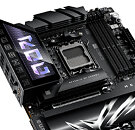
NVIDIA GeForce RTX 5080 Mobile GPU Benched, Approximately 10% Slower Than RTX 5090 Mobile
NVIDIA and its laptop manufacturing partners managed to squeeze out higher end models at the start of the week (March 31); qualifying just in time as a Q1 2025 launch. As predicted by PC gaming hardware watchdogs, conditions on day one—for the general public—were far from perfect. Media and influencer outlets received pre-launch evaluation units—Monday's embargo lift did not open up floodgates to a massive number of published/uploaded reviews. Independent benchmarking of Team Green's flagship—GeForce RTX 5090 Mobile—produced somewhat underwhelming results. To summarize, several outlets—including Notebookcheck—observed NVIDIA's topmost laptop-oriented GPU trailing way behind its desktop equivalent in lab tests. Notebookcheck commented on these findings: "laptop gamers will want to keep their expectations in check as the mobile GeForce RTX 5090 can be 50 percent slower than the desktop counterpart as shown by our benchmarks. The enormous gap between the mobile RTX 5090 and desktop RTX 5090 and the somewhat disappointing leap over the outgoing mobile RTX 4080 can be mostly attributed to TGP."
The German online publication was more impressed with NVIDIA's sub-flagship model—two Ryzen 9 9955HX-powered Schenker XMG Neo 16 test units—sporting almost identical specifications—were pitched against each other, a resultant mini-review of benched figures was made available earlier today. Notebookcheck's Allen Ngo provided some context: "3DMark benchmarks...show that the (Schenker Neo's) GeForce RTX 5080 Mobile unit is roughly 10 to 15 percent slower than its pricier sibling. This deficit translates fairly well when running actual games like Baldur's Gate 3, Final Fantasy XV, Alan Wake 2, or Assassin's Creed Shadows. As usual, the deficit is widest when running at 4K resolutions on demanding games and smallest when running at lower resolutions where graphics become less GPU bound. A notable observation is that the performance gap between the mobile RTX 5080 and mobile RTX 5090 would remain the same, whether or not DLSS is enabled. When running Assassin's Creed Shadows with DLSS on, for example, the mobile RTX 5090 would maintain its 15 percent lead over the mobile RTX 5080. The relatively small performance drop between the two enthusiast GPUs means it may be worth configuring laptops with the RTX 5080 instead of the RTX 5090 to save on hundreds of dollars or for better performance-per-dollar." As demonstrated by Bestware.com's system configurator, the XMG NEO 16 (A25) SKU with a GeForce RTX 5090 Mobile GPU demands a €855 (~$928 USD) upcharge over an RTX 5080-based build.
The German online publication was more impressed with NVIDIA's sub-flagship model—two Ryzen 9 9955HX-powered Schenker XMG Neo 16 test units—sporting almost identical specifications—were pitched against each other, a resultant mini-review of benched figures was made available earlier today. Notebookcheck's Allen Ngo provided some context: "3DMark benchmarks...show that the (Schenker Neo's) GeForce RTX 5080 Mobile unit is roughly 10 to 15 percent slower than its pricier sibling. This deficit translates fairly well when running actual games like Baldur's Gate 3, Final Fantasy XV, Alan Wake 2, or Assassin's Creed Shadows. As usual, the deficit is widest when running at 4K resolutions on demanding games and smallest when running at lower resolutions where graphics become less GPU bound. A notable observation is that the performance gap between the mobile RTX 5080 and mobile RTX 5090 would remain the same, whether or not DLSS is enabled. When running Assassin's Creed Shadows with DLSS on, for example, the mobile RTX 5090 would maintain its 15 percent lead over the mobile RTX 5080. The relatively small performance drop between the two enthusiast GPUs means it may be worth configuring laptops with the RTX 5080 instead of the RTX 5090 to save on hundreds of dollars or for better performance-per-dollar." As demonstrated by Bestware.com's system configurator, the XMG NEO 16 (A25) SKU with a GeForce RTX 5090 Mobile GPU demands a €855 (~$928 USD) upcharge over an RTX 5080-based build.










































































